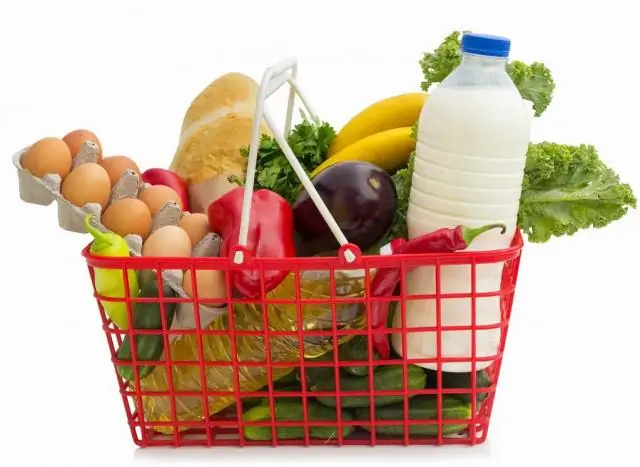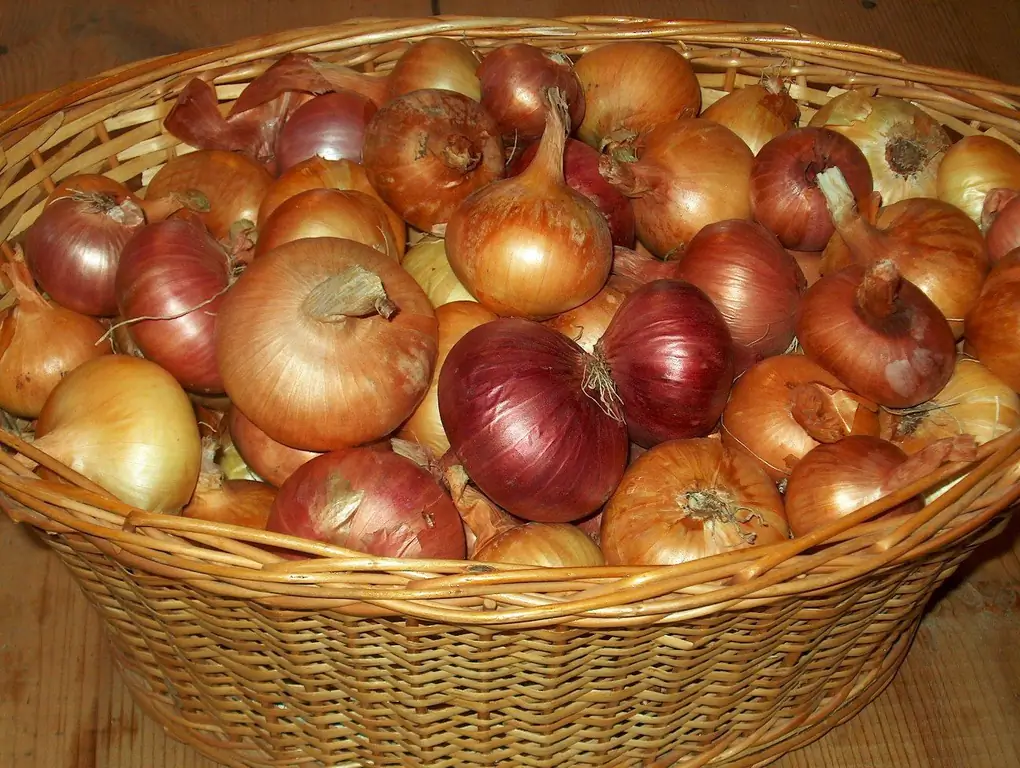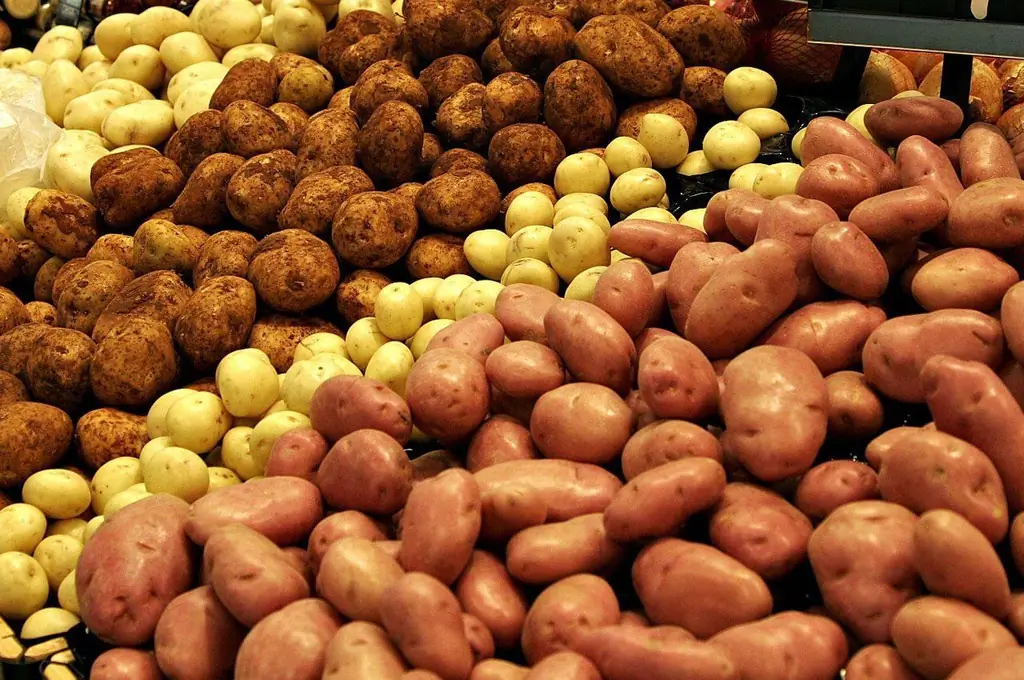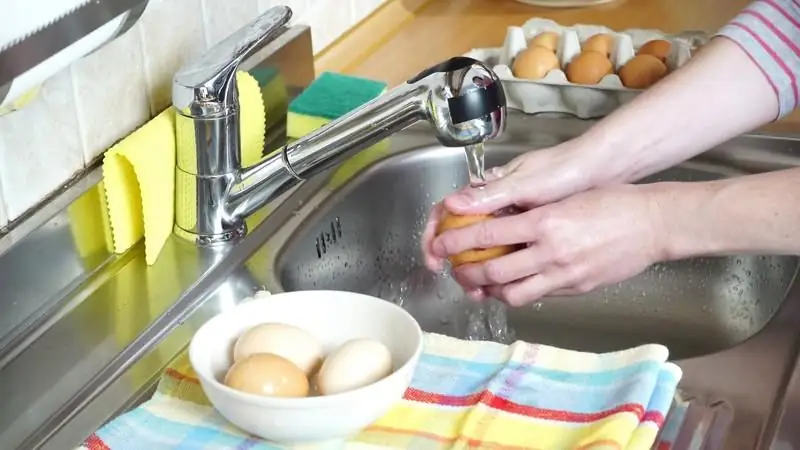
Table of contents:
- Author Bailey Albertson [email protected].
- Public 2024-01-17 22:26.
- Last modified 2025-06-01 07:32.
How to keep the potato crop for a long time

Breeders have bred more than four hundred varieties of potatoes, differing in terms of planting and ripening, yield, disease resistance, as well as taste.
Content
-
1 General recommendations
1.1 Video: important nuances regarding storing potatoes
-
2 Best varieties for storage
- 2.1 Picasso
- 2.2 Zhuravinka
- 2.3 Asterix
- 2.4 Lorch
- 2.5 Atlas
- 2.6 Vesnyanka
- 2.7 Romano
- 2.8 Santa
- 2.9 Condor
- 2.10 Nevsky
- 3 Optimal conditions for storing potatoes
- 4 How to prepare the crop for storage
-
5 Potatoes in the cellar
5.1 Video: how to store potatoes in the cellar
-
6 Storage at home
6.1 Video: DIY mini-cellar on the balcony
-
7 Diseases Attacking Potatoes During Winter
- 7.1 Late blight
- 7.2 Rhizoctonia (black scab)
- 7.3 Dry fusarium rot
- 7.4 Wet bacterial rot
- 7.5 Ring rot
- 7.6 Phoma rot
- 7.7 Hard black rot
-
7.8 Non-communicable diseases
7.8.1 Photo Gallery: Non-communicable Potato Diseases
- 8 Features of storage of planting material
General recommendations
For long-term storage, choose potatoes of medium late and late varieties, the growing season of which is 100-140 days. The long growing season contributes to the formation of a thick peel on the tubers containing tannins that protect potatoes from diseases and pests.
When planting potatoes, the following are taken into account:
- Soil quality. Sandy loam soil is suitable for growing potatoes. Peat soil negatively affects the taste and shelf life, and nutritious chernozem is a favorable breeding ground for pathogenic fungi, viruses, bacteria.
- Correct fertilization. From an excess of nitrogen-containing preparations, the tubers will not form a thick rind, and the pulp will be "watery".
- Harvest time. The optimal time for harvesting potatoes is considered to be the time when the tops have already completely wilted, and the fruits are covered with a dense skin.
Video: important nuances regarding storing potatoes
The best varieties for storage
Modern breeding offers a wide range of late-ripening potato varieties.
Picasso
Root crops are large, round-oval. The mass of a commercial tuber is 90-130 g.
The peel is light yellow in color with pink eyes and spots around them. The pulp is light creamy, creamy in color with a low starch content - 10.5-12.5%, which is not typical for late varieties.

Picasso potatoes are low in starch and yield high yields
Small and deformed potatoes are practically not found. Productivity - 16-20 potatoes per bush. Ripens in 115-130 days. Recommended for cultivation in the European part of Russia.
The variety bears fruit stably, regardless of weather conditions. It tolerates transportation well. During storage, the tubers do not germinate, which ensures high keeping quality - 90%. Picasso needs enough nutritious soil or proper feeding, otherwise the taste of potatoes will noticeably deteriorate.
Zhuravinka
Medium late Belarusian variety. It demonstrates the best qualities when grown in the European part of Russia, including the North-West and the Urals. The growing season is 95-110 days.

Crane potatoes are resistant to the appearance of the Colorado potato beetle
Oval potatoes. The marketable weight of a tuber is 100-130 g. Each "nest" has 20-25 tubers, the arrangement is heaped. The skin is raspberry-red, smooth to the touch. The pulp is pale yellow. Potatoes show good keeping quality - at the level of 92-96%. Tubers with mechanical damage are also placed in the cellar.
The danger threatening potatoes, including during storage, is rhizoctonia and late blight. Zhuravinka is not attractive to the Colorado potato beetle, especially if there are other varieties on the site. This potato is sensitive to an excess of nitrogen in the soil and needs watering. Waterlogging and prolonged drought adversely affect keeping quality.
Asterix
This Dutch potato variety is prized by amateur gardeners and professional farmers for its combination of excellent taste and excellent keeping quality.

Potato Asterix is a drought-resistant medium-yielding variety with a high starch content
Elongated tubers. The skin is smooth, bright red with numerous small eyes. The marketable weight of the potato is 80-120 g. The flesh is pale yellow, it does not darken with mechanical damage. The starch content is 14.5-17.5%, Asterix almost does not need watering, it has good productivity in hot and dry summers. It is undemanding to the quality of the substrate.
Lorch
The pride of domestic breeding. Named for its creator, the famous breeder A. G. Lorkh.

Lorkh potatoes - an elite, high-yielding and moisture-loving variety
Lorkh belongs to the group of medium-late ripening varieties, the growing season is 85-105 days. The yield is high. Oval tubers with beige-yellow skin and white pulp. Marketable tuber weight 110-135 g.
The emerged seedlings need regular watering. Heat and moisture deficit negatively affect the keeping quality of tubers. You will also need to regularly apply fertilizers containing potassium and phosphorus - in the soil poor in these macronutrients, the tubers are often deformed.
Atlant
Late Belarusian variety, ripening period is 115-125 days. It owes its popularity to taste and resistance to all diseases characteristic of the culture, with the exception of phytophthora. Resistant to damage by the Colorado potato beetle. In Russia, it is grown in the Central and Central Black Earth regions.

The Atlant variety is resistant to diseases and damage by the Colorado potato beetle
Tubers are broadly oval. the skin is rough and thick, yellowish-cream in color with few eyes. The pulp is light. The marketable weight of the tuber is 90-125 g. Each nest contains 7-11 potatoes. Starch content - 17-22%. Demonstrates good keeping quality during storage.
Atlant is not whimsical to the quality of the substrate, but needs proper watering after flowering. In waterlogged soil, tubers begin to rot.
Vesnyanka
A variety of Belarusian potatoes with large, rounded tubers and small eyes. The skin is light beige, smooth to the touch. The pulp is pale yellow. The marketable weight of the tuber is 95-125 g. The ripening period is 115-125 days. The lack of potatoes of the Vesnyanka variety is a weak resistance to viral diseases, scab, late blight.

Potato variety Vesnyanka is susceptible to viral diseases
Vesnyanka is unpretentious in the quality of the substrate, bears fruit well in many regions of Russia.
When growing these potatoes, you should not get carried away with fertilizers. With an excess of nitrogen, potassium, phosphorus in the soil, tubers are deformed, keeping quality decreases sharply.
Romano
Dutch potatoes, belonging to the group of early ripening varieties. Zoned for the European part of Russia and the Far East. Possesses good keeping quality.
The growing season is 80-90 days.

Romano is one of the few potato varieties with a relatively short growing season that show very good keeping quality.
Tubers are small, short-oval in shape, covered with smooth pinkish skin. Marketable weight of the root crop is 75-90 g. Eyes are few and superficial. The pulp is creamy yellow with a starch content of 10.5-13%. Each "nest" has 7-13 tubers.
The variety bears fruit in almost any soil. It needs watering only in case of prolonged drought. Frost-resistant.
Santa
Tubers are regular, broadly oval in shape with a dense yellow rind. Marketable weight of the root vegetable is 120-160 g. The pulp is creamy yellow or almost white. The starch content in tubers is only 10-14.5%. Each "nest" contains 15-20 potatoes.

Sante potatoes are a low starchy variety with large tubers and sensitivity to cold weather
Despite the short growing season of 85-95 days, the Sante variety shows very good keeping quality
The variety is quite thermophilic, but weakly resistant to heat and drought. In case of frost, the yield drops noticeably. The Santa potato variety has genetically built-in protection against most common crop diseases, with the exception of late blight. In cool and rainy summers, the risk of root crops being damaged by rhizoctonia and "black leg" increases, and the keeping quality of tubers decreases. Santa is successfully cultivated throughout Russia.
Condor
A medium late Dutch variety with a growing season of about 90 days. The tubers are large in the form of an elongated oval, with a raspberry-red skin and bright yellow flesh. The marketable weight of the root crop is 100-180 g. The starch content in the tubers is 9.5-14.5%. The "nest" of the Condor variety is compact. 7-12 potatoes are obtained from one bush.

Potato variety Condor is distinguished by drought tolerance and the ability to adapt to soil and weather conditions
The variety has good "plasticity", successfully adapting to different climatic and weather conditions, type of soil. Highly resistant to drought and heat. Most of the harvested potatoes have a presentation, small and deformed - only 5-8% of the total.
Nevsky
Soviet variety, bred in the mid 70s of the last century. medium late, high-yielding variety. The growing season is 80-95 days. The tubers are large, weighing 110-135 g. The skin is thin, yellowish-beige with small pale pink eyes. The pulp is creamy. The quality of the substrate is unpretentious.

Potato Nevsky is a medium late thermophilic variety that demonstrates a high yield
Potato variety Nevsky is picky about storage conditions. The temperature in the storage room for potatoes should be 4-6 ° C. At higher temperatures, tubers germinate quickly. The variety is not sensitive to drought, but it is thermophilic. Tubers do not react well to cold soil, so they need to be planted when the threat of return frost has passed.
Optimal conditions for storing potatoes
The best storage space for potatoes is a cellar or basement. The potato storage must maintain a constant low above-zero temperature (2-4 ° C) and humidity at 75-85%. Good ventilation or weekly ventilation is imperative. Only if all conditions are met will it be possible to preserve the harvest until winter.
At elevated temperatures, the process of moisture evaporation is more active, the tubers consume more starch. As a result, the skin is quickly covered with wrinkles, the pulp will sag. In addition, these potatoes begin to sprout early.
In the sprouts of sprouted tubers, the poisonous substance solanine accumulates. Therefore, it is not recommended to eat potatoes with long sprouts. Unsuitable for human consumption are also green tubers that have been exposed to light.

It is not recommended to eat potatoes with very long sprouts
At 0 ° C, the reaction begins to convert the starch contained in the tubers into sugar. Because of this, the taste of potatoes deteriorates sharply, an unnatural sugary-sweet taste appears. At lower temperatures, the tubers freeze. Such potatoes rots very quickly, the flesh becomes loose and watery, almost tasteless. Tubers intended for planting give rare weak sprouts.
It is very important that the room is not damp. In such conditions, rot develops very quickly. To avoid this, holes for ventilation must be made in containers with potatoes and placed on pallets and other supports. Since condensation forms on the walls, the containers are pushed back at least 15-20 cm.

Dampness in the cellar dramatically reduces the shelf life of potatoes
It is advisable to fill boxes and boxes with heat-insulating material (for example, shavings or sawdust), which will protect the tubers from possible temperature changes and absorb excess moisture from the air. The thermal insulation layer must be renewed approximately every 1-1.5 months.
If ventilation is available, care must be taken to ensure that the outside air is approximately the same temperature as that maintained in the storage. The maximum permissible deviation is 2-3 ° C in any direction.
How to prepare crops for storage
Preparation for storing potatoes begins with mowing the tops 1-1.5 weeks before the expected harvest. This is an effective measure that reduces the risk of late blight and other fungal diseases during storage. Leave only stems 10-12 cm long. When they are completely wilted, they begin to harvest. After mowing the tops, the tubers can remain in the ground for a maximum of 18-20 days.

Late potatoes are harvested until the tops are completely dry
For harvesting, choose a dry, not too hot day. During the harvesting process, mechanical damage is minimized. The collected potatoes are sorted. Separately laid out deformed and damaged potatoes, potatoes intended for long-term storage and planting material for the next season. The harvested crop is dried for 5-6 hours in the open air, away from direct sunlight.

In the process of harvesting potatoes, it is advisable to use a pitchfork to minimize mechanical damage.
Then the potatoes intended for storage are laid out in 1-2 layers on the floor of a dry, dark room with good ventilation and a constant temperature of 16-18 ° C, spreading several layers of newspapers or a soft cloth. Microcracks and other lesions on the skin have time to heal in 1.5-2 weeks. Unripe potatoes will take longer (16-20 days) and a lower temperature (12-15 ° C). At this time, diseases appear. Tubers with the slightest suspicious signs are immediately discarded.

Drying the tubers is a mandatory procedure for both potatoes laid for long-term storage and for planting material for next year.
Potatoes in the cellar
Immediately before laying in the cellar, the tubers are sprayed with a solution of Fitosporin or Baktofit prepared according to the instructions. It is advisable to use a fine spray for this. Treat the entire surface of the tubers evenly. Then the potatoes must be dried well for 3-5 hours, periodically turning over.
The cellar is examined, measures are taken to exclude the access of rats, mice, and other rodents. The floor, shelves and other horizontal surfaces are wiped with a slaked lime solution (2 kg per 10 liters of water). For disinfection, a small piece of a sulfur checker is burned indoors.
The tubers are placed in wooden boxes or cardboard boxes. When storing potatoes in bulk, its height should not exceed 1.5 m. A layer of moisture-absorbing material (sawdust, straw, shavings, cardboard, scraps of paper) is laid on the bottom of the container.

A cellar or basement is the best option for storing potatoes, it is easiest to create a suitable microclimate there.
It is advisable to place potatoes for storage in the early morning so that the temperature difference is not too strong. In warm autumn, containers with ice or cold water can be used to cool the room. The plastic bottles removed from the freezer are placed in the cellar about two days before the harvest. The bottles are changed regularly.
Potatoes do not tolerate the neighborhood with other vegetables and fruits. The only exception is beets, which absorb excess moisture well. For the same purpose, containers with lumps of quicklime are placed in the cellar.
Additional protection against all types of pathogenic fungi will be provided by plants that emit phytoncides - wormwood, snowy, mountain ash, fern, elderberry. Layers of potatoes are overlaid with leaves. Peppermint prevents sprouting too early. For the same purpose, 2-3 ripe apples are placed in each box in spring.

Rowan leaves, emit phytoncides into the atmosphere, effectively destroying pathogenic fungi
Potatoes are examined at least once a month. Immediately remove rotted and all tubers in contact with them. The rest of the potatoes, lying in the same box, are powdered with crushed chalk, colloidal sulfur, sifted with wood ash.
Video: how to store potatoes in the cellar
Home storage
Potatoes can be stored for about 4 months in an apartment on a glassed-in balcony or loggia. A kind of mini-cellar, consisting of two boxes inserted into each other, will help to extend the shelf life. The gaps between the walls of these boxes are filled with any heat-insulating material.
The tubers themselves are placed in two bags before storage. The top of the box is closed with a blanket folded in several layers. If the temperature in winter does not drop below -15 ° C, the harvest will last until spring.

Potatoes can be stored in a mini cellar on the balcony
Potatoes are rarely stored directly in the apartment. As a rule, this is due to a lack of space and its rapid germination. But in the absence of other options, bags of tubers are placed in the coolest place (at the front door, a constantly open window). In this case, the potatoes must be protected from natural or artificial light.
Video: DIY mini-cellar on the balcony
Diseases Attacking Potatoes During Winter
With careful selection and optimal storage conditions, potatoes rarely suffer from diseases and can easily last until next summer. Nevertheless, once a month, it is necessary to carry out a preventive examination of the tubers.
The fight against diseases affecting potatoes is ineffective. To reduce the risk of disease, it is necessary to treat the tubers with chemicals to combat fungal diseases, monitor the condition of the crop, immediately remove diseased tubers and prevent the spread of infection. Therefore, not only infected potatoes are subject to culling, but also all those in contact with them. The rest of the tubers in the same container are sprinkled with colloidal sulfur or crushed chalk. Experienced gardeners do not recommend going through the entire crop, so as not to transfer fungal spores from diseased tubers to healthy ones with their hands.
It is quite possible to stop the "epidemic" developing in the cellar if the recommended storage conditions are observed and the infected tubers are discarded. "Doubtful" potatoes are laid separately, keeping "quarantine" for 10-12 days. During this time, most diseases are clearly manifested.
Late blight
Fungal disease manifested in the form of round, depressed spots on the peel of a grayish-brown color and the appearance of brownish "streaks" in the pulp. Potatoes rots quickly.

Mowing the tops before harvesting helps to minimize the risk of late blight
The fungus enters the tissue through mechanical damage and microcracks obtained during cleaning. Therefore, it is important to harvest potatoes on time, as unripe tubers have a very thin, flaky rind onto which the fungus can spread from the tops. If the tops have not been cut, they must be removed from the garden where the tubers are dried.
For the prevention of late blight, potatoes are sprayed with a solution of Bordeaux liquid or copper sulfate (2-3 ml or 3-4 g per 2 liters of water) about a day before laying for storage and the tubers are thoroughly dried. Oleocuprin, Kuprozan, Kuproksat are also widely used. It is advisable to dry potatoes in the open air, in a well-ventilated place, under a canopy, protected from direct sunlight.
Rhizoctonia (black scab)
The tubers are covered with small black-brown specks, similar to adhering soil particles. They can be easily scraped off with a fingernail, for example, but cannot be washed off. Such potatoes are quite suitable for eating, but planting is strongly discouraged in order to avoid large crop losses.

Potato tubers affected by rhizoctonia and intended for planting are immediately discarded.
Most often, rhizoctoniasis develops with late harvesting of potatoes. When stored under appropriate conditions, infection rarely spreads to other tubers. But if the temperature in the cellar is more than 5 ° C or more, the potatoes are covered with dark gray mycelium threads. Weeping "ulcers" appear on the skin, the flesh under them turns into brownish dust.
For the prevention of rhizoctonia, it is important to observe crop rotation, the use of green manure plants. Humus and sifted wood ash are introduced into the holes during planting. Potatoes prepared for storage are sprayed with a solution of Agatha-25, Planriz, Maxim.
Dry fusarium rot
It can begin to develop during the entire storage period, but the end of winter is especially dangerous in this regard. On the tubers, depressed blurry spots of lead-gray appear. Then the skin wrinkles in these places, the pulp dries out under it, voids are formed, filled with small grayish-yellow dust - fungal spores. As a result, the potato turns into a "mummy".

As a result of the development of dry fusarium rot, the potato pulp turns into small dry dust
Most often, the source of the appearance of the fungus is soil particles adhering to the tubers. Tubers, with the slightest damage, will become infected almost inevitably, whole ones will not be affected, but only if their skin is not covered with condensation or drops of moisture.
There are no special methods of dealing with dry fusarium rot.
Wet bacterial rot
The skin of the tubers darkens, the pulp turns gray and softens, then turns into a gruel with an unpleasant putrid smell. Brownish mucus is secreted on the surface of the tuber.

Wet bacterial rot is one of the diseases that develop very quickly
The disease develops already in the first month of storage. This is facilitated by mechanical damage to the skin, the presence of other diseases, hypothermia, as well as too "heavy" substrate in the garden and excess nitrogen-containing fertilizers, because in such soil, potatoes "suffocate", unable to develop properly. The disease spreads very quickly, the tuber rots completely in 1.5-2 weeks.
To avoid the appearance of wet rot, you need to constantly maintain the optimal temperature in the storage. Ventilation is equally important. Otherwise, losses can amount to more than 50% of the total harvest.
Ring rot
The disease is noticeable only when cutting the tuber. A yellowish-beige ring is visible in the pulp under the skin. If you squeeze the tuber, a white-yellow liquid will ooze from it. Then the whole core rots, the pulp turns into a mass with an unpleasant odor. Rapidly growing rounded "pits" appear on the skin.

It is almost impossible to notice the development of ring rot during the harvesting process.
The disease is transmitted by using low-quality planting material, from diseased tubers - by new ones. Therefore, it is worth very carefully selecting seed potatoes, and in case of mass infection, completely changing it. It is almost impossible to notice the first signs of rot when laying for storage, the disease develops already in the cellar.
Phoma rot
Tubers can become infected with phoma rot only through mechanical damage in the skin. The infection is spread through soil particles or infected foliage. Small rounded spots appear on the potatoes, the skin in these places seems to be stretched. Then these areas crack, becoming covered with a grayish "pile". The pulp under them turns brown, dries up.

Tubers that do not have mechanical damage are not affected by phoma rot
The optimum temperature for the development of phoma rot is more than 10 ° C, so you need to carefully monitor the temperature in the storage facility. Other effective preventive measures are competent agricultural technology, observance of crop rotation.
Solid black rot
It develops in spring when the temperature in the store rises. Rapidly increasing black spots appear on the skin, the flesh under them dries up, cavities form in it. If the humidity in the room is too high, a greenish-brown mucus appears on the surface of the tubers.

Hard black rot most often develops when potatoes reach the end of their shelf life.
The most effective prevention is to dry the tubers before storing them. Potatoes with dense skin and healed microcracks are much less likely to be affected by this disease, even if the storage conditions differ from optimal ones.
Non-communicable diseases
In addition to fungal and bacterial diseases of potatoes, there are other non-infectious diseases.
- Melanosis. In some places, the pulp acquires a dark grayish-brown hue. The reason - blows, pressing, other damage that did not lead to injury to the skin. Also, melanosis sometimes develops when potatoes are harvested too early, there is a shortage of potash fertilizers in the soil, and there is no watering in hot summer.
- "Strangulation" of tubers. The places of appearance of future sprouts swell and turn white, rot begins to spread from them. The reason is the lack of fresh air during storage or too "heavy" substrate in the garden.
- Thermal damage. The skin wrinkles, the pulp in the middle of the tuber loses its elasticity, darkens, sometimes cracks. This most often occurs when the harvested potatoes have been in direct sunlight for too long. The lack of ventilation in the potato storage has a negative effect.
- Freezing. If a thawed potato is squeezed in a fist, a clear liquid oozes out of it. The pulp on the cut quickly turns pink, then takes on a black-brown tint. The reason is the drop in temperature in the storage facility below 0 ° C. The situation can be slightly improved by keeping the affected tubers at room temperature for 5-7 days. The pulp will become less watery, the unpleasant sweetish taste will disappear.
- Glandular spot ("rustiness"). In some places, the pulp acquires a coppery-rusty hue. The main reason is the lack of phosphorus fertilizers and calcium deficiency. Particular attention should be paid to feeding if the soil in the garden is sandy, and the summer turned out to be dry and hot.
- The appearance of the "hollow". In the pulp, voids of various shapes and sizes are formed, "lined" from the inside with a pinkish-beige skin. It is provoked by waterlogging of the soil and an excess of nitrogen-containing fertilizers. Most often "hollows" appear in the largest tubers.
- Cracks in the skin. They should not be confused with the "mesh" which is a characteristic feature of some varieties. The appearance of deep cracks causes sharp fluctuations in soil moisture, improper application of fertilizers or their increased doses. Because of this, tubers grow unevenly, "jerky".
Photo gallery: non-communicable potato diseases
-

Melanosis - Melanosis does not affect the edibility of potato tubers.
-

"Strangulation" of tubers - "Strangulation" is caused by the fact that tubers cannot develop normally in too dense soil
-

Thermal damage - Heat damage to potatoes is about the same as sunburn to humans
-

Freezing - The flesh of frozen potatoes takes on an unnatural pinkish tint
-

Glandular spot - Glandular spotting occurs when certain fertilizers are deficient
-

The appearance of the "hollow" - "Hollow" most often appear in the pulp of large potatoes
-

Cracks in the skin - Cracks in the skins of potatoes are caused by uneven growth of tubers
Features of storage of planting material
Storing seed potatoes is not much different from storing tubers for human consumption. It is important to separate the tubers separately to avoid confusion. Greening the potatoes beforehand makes the potatoes unfit for human consumption.
The planting material must be disinfected by spraying with a 2% solution of copper sulfate or Bordeaux liquid, then dried well. Seed potatoes are poured into boxes or boxes in no more than 2-3 layers so that the sprouts do not appear earlier than the appointed time.

Copper sulfate is one of the most common fungicides used to prevent the development of fungal diseases.
The main thing is to get the tubers for planting to germinate on time. It is impossible to break off the emerging sprouts too early, this reduces the future yield by 20-30%. It is important to ensure a suitable temperature, gradually raising it to 23-25 ° C. Outside this range, the process is greatly inhibited. Tubers are placed in a dark place or covered with a dense cloth - in direct sunlight, the sprouts will be green and very short. As soon as the growth buds swell, they need to be brought out into the light so that they do not turn out to be threadlike, thin and whitish.
You can store small quantities of planting potatoes in the refrigerator in a special compartment for fruits and vegetables. The alternative is the coolest place in the apartment.
Preserving your potato crop is easy. Subject to the storage conditions, the tubers will last until next spring. The best storage place is a cellar or basement, but if it is not available, potatoes can be stored at home.
Recommended:
How To Make Yogurt At Home - Recipes For Making Drinking, Greek And Other Options From Milk (including Goat Milk), In And Without A Yogurt Maker, Video And Reviews

Properties and types of yoghurts. How to choose products. Homemade recipes in a yogurt maker and without
How To Store Onions, Including Seedlings, Leeks, At What Temperature And Conditions Does It Lie Well In Winter + Photos And Videos

How to store onions and green onions correctly? What storage methods are there? Storage problems and solutions
Potato Storage: How To Properly Carry Out At Home, The Required Temperature, Including In The Winter On The Balcony Of The Apartment

How and where to store potatoes. Container for storage at home. Is it possible on the balcony. Errors
Dry And Hot Nose In A Cat Or Cat: Causes (a Symptom Of What Diseases And Conditions May Be) Phenomena In Kittens And Adult Animals

In what situations a warm and dry nose in a cat is normal, and when in case of illness. How to understand that a cat is sick. When a doctor is urgently needed. Recommendations
Do I Need To Wash Eggs Before Cooking And Storing Them, Including In The Refrigerator?

Do I need to wash chicken eggs before cooking, before storage and after purchase, before beating and in other cases. What does washing affect
